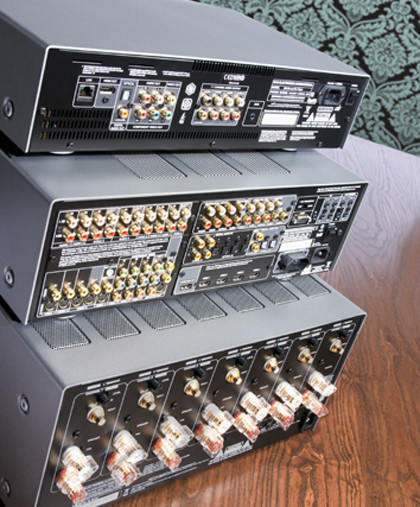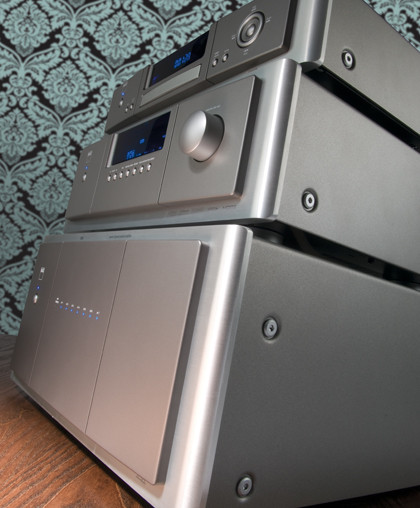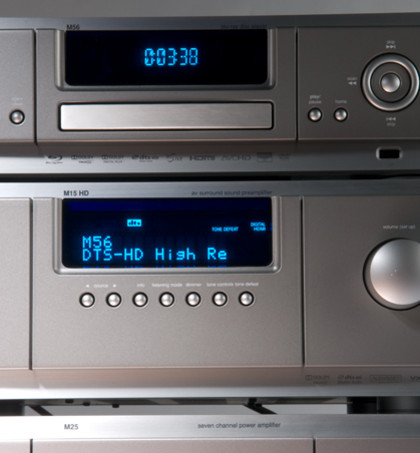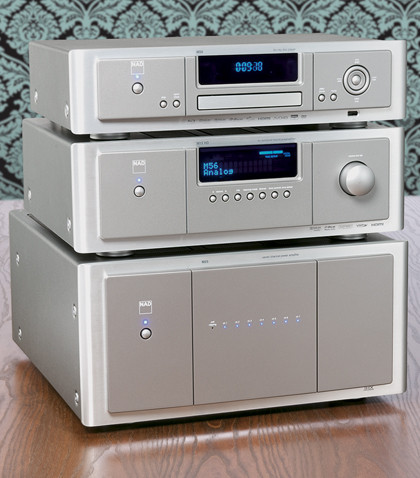TechRadar Verdict
Pros
- +
Innovative modular design
- +
Fantastic audio performance
- +
Heavyweight build
- +
Wi-Fi BD link
Cons
- -
Average Blu-ray motion processing
- -
No balanced XLR inputs or height/width processing
Why you can trust TechRadar
You can only love or loathe the wall of buff metal-work that is the full-fat NAD Masters Series home cinema system.
As a high-end range of components the design is every bit as funky, industrial and quirky as the near £9,000 price ticket suggests, albeit cosmetically almost identical to the original Masters Series setup reviewed and raved about by HCC around three years ago.
What has changed is the technology on the inside. Okay, the M25 power amplifier is the same potent, class AB, fun-loving seven channel beast, but the source and processor are much advanced on the old models.
The M56 is a fully Wi-Fi enabled Blu-ray player, meaning that even if you can't run a network cable to your AV room, you can still access BD-Live content and firmware updates over your wireless network. It claims to offer super-fast discloading, and the usual 1080p24 output, 1080p upscaling of DVDs and on-board decoding and 192kHz DACs for Dolby True HD and DTS-HD. It handles DivX HD discs without a wobble and the internals look like an exercise in heavy-duty engineering.
Under the lid it is all heavy-weight PCBs and chunky great components with a serious look about them, indicating copious R&D investment in the audio and video performance department. It does indeed spin up a disc in next to no time (our Tech Labs recorded an impressive 47-second loading time), which is something to appreciate if your current BD spinner needs a week's notice before rolling the credits.
Slightly annoyingly, the drawer doesn't allow the disc to clear the fascia completely, resulting in a few platter-flipping incidents before I got the hang of easing them out forwards. That's only a minor gripe, though.
In terms of menus, the M56 is a world removed from the stoic text-heavy menus of NAD's previous M55 DVD/universal player. It is a slick full-colour graphic user interface that sees off much of its mainstream competitors with an applaudable combination of cosmetic charm and simple usability.
Even the Wi-Fi network setup is a dream, and didn't require any of the usual repositioning, continuously relocating the network, DNS protocol problems (whatever the hell they are...) or hardcore swearing and reverting to a wired connection.
A USB port on the front of the M56 accepts the usual range of multimedia formats and doubles as additional BD-Live storage should the internal memory run out of space (and assuming someone ever creates some worthwhile BD-Live content...).
Finishing touches include a vivid blue display (dimmable, of course) and a chunky aluminium topped remote control. All of the constituent features and parts of the M56 add up to a cracking package, but the pudding wasn't quite the proof it should have been. More of which later.
M is for modular
Virtually the only thing that the original M15 and the new M15HD have in common is their peculiar visual charm. I like it, but in the same way I always found Carol Vorderman quite fanciable. The M15HD is a radical new design whose biggest selling point for anyone fed up with the increasing cost of chasing the latest technology (cue plenty of HCC readers nodding in agreement...) is its completely modular design.
Very much like a high-end PC, almost every major module is board-mounted with a connection panel that projects through the rear panel of the player. At the time of writing there are no Masters Series upgrade modules available, but the concept is already in full flow with NAD's step-down T-series AV receivers, with available audio and video modules allowing buyers to spec different levels of HDMI connectivity, Audyssey processing/setup, different DSP speeds, etc.
But the advantage of NAD's modular concept goes further, by offering a degree of future-proofing. Theoretically, when the next big DTS/Dolby format comes along, you'll be able to just upgrade to a new audio board. Really need the bandwidth and Ethernet channel of HDMI v1.4 for 3D? Then simply spec a new video board rather than buy a whole new processor.

While I am sworn to secrecy on what modules are in the pipeline, expect boards with greater HDMI inputs/outputs, home automation boards integrating Control 4 protocol, and a board that offers bi-directional multimedia streaming over Wi-Fi. Ooops, I might have let a cat out of the bag there.
And it is not only the modular design that sets the M15HD apart from its forebear. This beast has four times the processing power of the original, including the very latest 32bit floating point DSPs and 128x oversampling ADCs for analogue audio inputs.
Then there's sigma's vXP video engine, an absolute peach of a piece of electronics, derived from the pro-broadcast world and capable of handling HD formats up to 2048 x 2048 resolution. While that is never going to be a domestic standard, 1080p should be a walk in the park. The VXP engine's output feeds a suite of ultra-high-speed DSPs, meaning a video latency of less than 20ms even at 1080p/60Hz and full-bore cinematic action.
The old M15 was a bit short on features compared to the competition at the time, but the designers of the M15HD have clearly been shopping. Three independent zones, masses of CI features and an RS232 interface, PC-programmable remote control, a much slicker GUI, iPod dock connection, second remote and enough hard-core audiophile components to keep music lovers happy.
There isn't quite the depth of video tweakery available with, say Denon's AVP-A1UD, nor any THX certification, USB compatibility or Audyssey DSX/Dolby Pro-Logic IIz shenanigans, but it's otherwise right up there with the features-fest alternatives. Blimey – and from NAD, too!
The old M15 won many admirers and a lot of international awards for its flexibility and all round sonic virtues, including an HCC Reference Status badge. A lot of those accolades were derived from NAD's philosophy of simplicity, performance and value, the old M15 being just £2,000 in its day.
So, with many more features, bristling with cutting-edge modular design and offering some high-end third party components, can the M15HD be as impressive now its price has soared to £4,000?
M is for monstrous
Moving away from all that serious DSP and digital wizardry for a dose of Brunel scale engineering, let's take another look at the M25 seven channel power amplifier. It is a staunchly old-school analogue amplifier with a traditional mix of whopping great power supplies, capacitors that could store the average lightning strike and chunky copper bus bars you could run a passenger mono-rail on.
It still weighs 44Kg, it's still the size of most Krells, still has hawser-sized speaker binding posts, and still offers a solid 160W per channel. I fell in love with this beast a few years back, bordering on selling the then current amps to fund two M25s to bi-amp my speaker system. The problem was that it just lacked balanced XLR inputs... and still does.
One interesting facet of the M25's design is what NAD terms Powerdrive. This circuit engages a second high-voltage rail that nearly doubles the continuous power on a short-term dynamic basis for huge peaks. It was this dynamic aplomb, along with a penchant for an energetic and up-front presentation, that made the M25 thoroughly addictive with pretty much any sci-fi/action/adventure blockbuster ever made.
For those of a 'nervous about my expensive loudspeakers' disposition, the M25 also offers a switchable soft clipping feature. If you are completely barking mad and/or stone deaf and want to drive the M25 to its limits, this feature offers gentle 'peak' clipping rather than full-scale distortion. Given the M25s power and current reserves, you would probably be picking bits of speaker driver out of the sofa first.

As I cautioned last time I reviewed the M25, if you see the soft clipping light illuminate, seek urgent medical attention.
M is for mature
The previous Masters Series setup was a strap-yourself-in-for-a-ride winner from the very first disc. Big, bold and brazen-sounding, if lacking in subtlety as a whole.
The new M56, M15HD, M25 setup loses little in raw drive and energy but adds a layer of class and refinement to elevate the system into the next league. It has masses of energy – cranking up the volume with Michael Jackson's This Is It Blu-ray is still likely to see even elderly relatives moon-walking across the room and grabbing their crotch – but the difference now is that they would be wearing a white glove and leather trousers, too. It's all in the detail.
The previous system found adrenaline at the slightly ragged edge of perfection, sacrificing finer details for plenty of character and a party disposition. The Masters Series has grown up now, replacing a bit of its wild-eyed youthful exuberance with an altogether more civilised sound.
Dialogue is laid slightly further back in the mix but never shouts at you, effects are rich and textured as opposed to simply crushing, and the overall balance is a little darker and more sophisticated. As the M25 is the same beast, the sonic differences are largely down to the M15HD processor and its new high-end components. This justifies the financial jump from old to new with ease.

As for the picture, semi static scenes and cut-shot pictures have all the depth, colour and raw contrast one has come to expect from top-flight Blu-ray players. It is a little shy of the range-topping Denon and Pioneer decks in terms of absolute image parameters but it gets very close for around half the price of those machines.
A runthrough of Pixar's Up on Blu-ray (rapidly becoming one of my favoured test discs) provided a veritable cornucopia of colour and shading, with Carl's facial detailing and expressions making the poignant parts of the film all the more heart-rending. Meanwhile, the shaggy fur on Dug the dog's coat was rendered rich and lifelike, and the interior of Munt's airship was suitably Victorian and moodily-lit with plenty of texture on the walls and floor.
However, the M56 is not all roses. In my opinion, its motion-processing is well below the upper echelons of the Blu-ray spinning elite. Big, complex pans lack the silky smoothness of the very best players and even the scrolling credits at the end could be a little more liquid and less jarring.
Having swapped cables, processors, players and even video displays to assess where the issue lie, the root cause fell firmly at the feet of the M56. The motion processing is about on par with the PS3 playing a Blu-ray, which, while not unwatchable, isn't anywhere near what I would expect for a £2,000 machine.
Thankfully the audio dynamite of the M15HD/M25 pairing more than makes amends for minor picture issues, and a whole evening feature-film fest of The Matrix followed by The Fifth Element followed by Serenity got two thumbs up. The oomph and dynamic power of the M25 works perfectly with the poise and detail of the M15HD, offering excellent emotional involvement at low-level listening, and an epic visceral experience at higher volumes.
The taxi-chase scene at the beginning of The Fifth Element is fast-paced and furious with huge bass and a thumping Brazilian rhythm. You can't help but get lost in the thrill ride, with subtle effects etched into the mix. The detritus clattering around the inside of the cab is understated and oft drowned out by the cab's engines and music beat, but the Masters Series makes sure you can hear every click, pop and scrape.
M is for Mmmmmm
So, NAD's new Masters Series trio generally stands up extremely well for its £8,600 asking price, and the build quality fights on a higher level still – note that the amp and processor are almost twice as heavy as Onkyo's top-end equivalents and the M56 is some five times the mass of Onkyo's BD-SP807 player.

The M15HD's modular design could also offer a lower-cost upgrade route into the future of home cinema, and the overall package has a refi nement that was a little lacking in previous incarnations. The M15HD polishes the original diamond's roughness without losing too much of its inherent audio sparkle – the system is still a beast when it comes to dynamic aplomb and sheer audio thrills.
Sadly the M56's motion processing lets the side down and stops me unreservedly recommending the whole trio, although the rest of this player's picture parameters were top-notch NAD's heavyweight amp and slick processor, however, can easily be considered Best Buy products – run, don't walk, to your local NAD dealer today and get yourself an audition.
Follow TechRadar Reviews on Twitter: http://twitter.com/techradarreview
